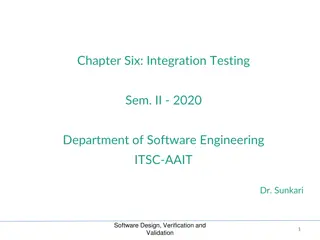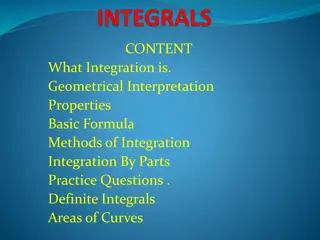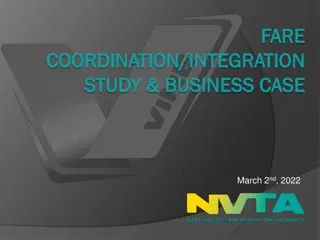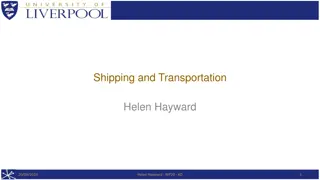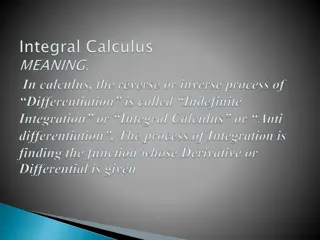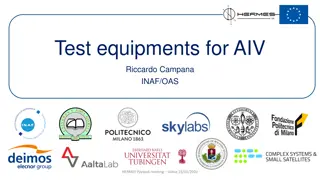Understanding Integration Testing and Levels of Testing
Explore the importance of integration testing in software development, covering topics such as traditional testing levels, the SATM system, goals and purposes of integration testing, testing level assumptions and objectives, software process overview, various approaches to integration testing, and the waterfall model's phases and drawbacks.
Download Presentation

Please find below an Image/Link to download the presentation.
The content on the website is provided AS IS for your information and personal use only. It may not be sold, licensed, or shared on other websites without obtaining consent from the author. Download presentation by click this link. If you encounter any issues during the download, it is possible that the publisher has removed the file from their server.
E N D
Presentation Transcript
UNIT 4 Levels of Testing, Integration Testing
contents Levels of Testing, Integration Testing: Traditional view of testing levels, Alternative life-cycle models, The SATM system, Separating integration and system testing. A closer look at the SATM system, Decomposition-based,call graph-based, Path- based integrations.
Goals/Purpose of Integration Testing Presumes previously tested units Not system testing Tests functionality "between" unit and system levels Basis for test case identification?
Testing Level Assumptions and Objectives Unit assumptions All other units are correct Compiles correctly Integration assumptions Unit testing complete System assumptions Integration testing complete Tests occur at port boundary Unit goals Correct unit function Coverage metrics satisfied Integration goals Interfaces correct Correct function across units Fault isolation support System goals Correct system functions Non-functional requirements tested Customer satisfaction.
The software process A structured set of activities required to develop a software system Specification; Design; Validation; Evolution. A software process model is an abstract representation of a process. It presents a description of a process from some particular perspective.
Approaches to Integration Testing ( source of test cases) Functional Decomposition (most commonly described in the literature) Top-down Bottom-up Sandwich Big bang Call graph Pairwise integration Neighborhood integration Paths MM-Paths Atomic System Functions
Waterfall model phases Requirements analysis and definition System and software design Implementation and unit testing Integration and system testing Operation and maintenance The main drawback of the waterfall model is the difficulty of accommodating change after the process is underway. One phase has to be complete before moving onto the next phase.
Evolutionary development Problems Lack of process visibility; Systems are often poorly structured; Special skills (e.g. in languages for rapid prototyping) may be required. Applicability For small or medium-size interactive systems; For parts of large systems (e.g. the user interface); For short-lifetime systems.
Spiral development Process is represented as a spiral rather than as a sequence of activities with backtracking. Each loop in the spiral represents a phase in the process. No fixed phases such as specification or design - loops in the spiral are chosen depending on what is required. Risks are explicitly assessed and resolved throughout the process.
System Testing Contents 1.System Testing Overview 2.Functional system Testing 3.Non-functional system Testing
System Testing overview Testing complete system. It is done by independent Tester. Bring in customer perspective in testing. Objective is to find product level defects and in building the confidence before the product is released to the customer. Provide a fresh pair of eyes to discover defects not found earlier by testing.
Contents A closer look at the SATM system Decomposition based Integration
Closer look at SATM SYSTEM The unit Calling graph is the directed graph in which nodes are program units and edges corresponds to program calls.
Decomposition Based Integration The goal is to interface Among Separately tested units. We can obtain four integration strategies based on functional decomposition tree 1.Top down 2.Bottom Up 3.Sandwich 4.Big bang
Top down Top down integration begin with the main program. Any lower level unit that is called by main program appear to be stub Stub: they are piece of throwaway code that emulate a called unit It follows breadth first traversal
Bottom up Integration It s mirror image to the top down approach. Only change is we use Drivers instead of stubs.
Top-Down Integration Mechanism Breadth-first traversal of the functional decomposition tree. First step: Check main program logic, with all called units replaced by stubs that always return correct values. Move down one level replace one stub at a time with actual code. any fault must be in the newly integrated unit
Bottom-Up Integration Mechanism Reverse of top-down integration Start at leaves of the functional decomposition tree. Driver units... call next level unit serve as a small test bed drive the unit with inputs drivers know expected outputs As with top-down integration, one driver unit at a time is replaced with actual code. Any fault is (most likely) in the newly integrated code.
Call Graph-Based Integration Definition: The Call Graph of a program is a directed graph in which nodes are unit edges correspond to actual program calls (or messages) Call Graph Integration avoids the possibility of impossible edges in decomposition- based integration. Can still use the notions of stubs and drivers. Can still traverse the Call Graph in a top-down or bottom-up strategy.
Call Graph-Based Integration (continued) Two strategies Pair-wise integration Neighborhood integration Degrees of nodes in the Call Graph indicate integration sessions isLeap and weekDay are each used by three units Possible strategies test high indegree nodes first, or at least, pay special attention to popular nodes
Pair-Wise Integration By definition, and edge in the Call Graph refers to an interface between the units that are the endpoints of the edge. Every edge represents a pair of units to test. Still might need stubs and drivers Fault isolation is localized to the pair being integrated
Neighborhood Integration The neighborhood (or radius 1) of a node in a graph is the set of nodes that are one edge away from the given node. This can be extended to larger sets by choosing larger values for the radius. Stub and driver effort is reduced.
Path-Based Integration Wanted: an integration testing level construct similar to DD-Paths for unit testing... extend the symbiosis of spec-based and code-based testing to the integration level greater emphasis on behavioral threads shift emphasis from interface testing to interactions (confutations) among units Need some new definitions source and sink nodes in a program graph module (unit ) execution path generalized message MM-Path


